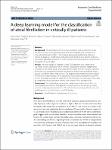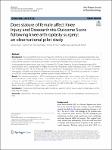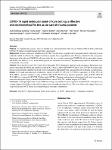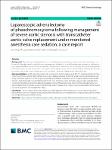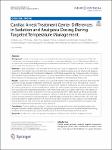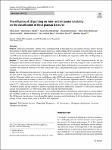Search
Author
- Daqing, Ma (3)
- Alexis, Ferré (2)
- Anna, Lybeck (2)
- Ashish K., Khanna (2)
- next >
Subject
- intensive care unit (8)
- acute respiratory dist... (5)
- chronic obstructive pu... (5)
- ICU (5)
- next >
Date issued
Has File(s)
Search Results
In military trauma, disaster medicine, and casualties injured in remote locations, times to advanced medical and surgical treatment are often prolonged, potentially reducing survival and increasing morbidity. Since resuscitation with blood/blood components improves survival over short pre-surgical times, this study aimed to evaluate the quality of resuscitation afforded by blood/blood products or crystalloid resuscitation over extended ‘pre-hospital’ timelines in a porcine model of militarily relevant traumatic haemorrhagic shock. |
High ratio of the carbon dioxide veno-arterial difference to the oxygen arterial-venous difference (PvaCO2/CavO2) is associated with fluid bolus (FB) induced increase in oxygen consumption (VO2). This study investigated whether PvaCO2/CavO2 was associated with decreases in blood-lactate levels FB in critically ill patients with hyperlactatemia. |
Using computer simulation we investigated whether machine learning (ML) analysis of selected ICU monitoring data can quantify pulmonary gas exchange in multi-compartment format. A 21 compartment ventilation/perfusion (V/Q) model of pulmonary blood flow processed 34,551 combinations of cardiac output, hemoglobin concentration, standard P50, base excess, VO2 and VCO2 plus three model-defining parameters: shunt, log SD and mean V/Q. |
Atrial fibrillation (AF) is the most common cardiac arrhythmia in the intensive care unit and is associated with increased morbidity and mortality. New-onset atrial fibrillation (NOAF) is often initially paroxysmal and fleeting, making it difficult to diagnose, and therefore difficult to understand the true burden of disease. Automated algorithms to detect AF in the ICU have been advocated as a means to better quantify its true burden. |
Knee osteoarthritis (OA) occurs frequently in females. So far, no study has evaluated postoperative outcome measures in females based on body height. We aimed to evaluate postoperative pain relief and Knee Injury and Osteoarthritis Outcome Score (KOOS) at 6 months in women following total knee arthroplasty (TKA). |
To evaluate the accuracy and cost benefit of a rapid molecular point-of-care testing (POCT) device detecting COVID-19 within a traumatological emergency department. |
Management of a patient with an active pheochromocytoma and severe aortic stenosis remains controversial. Adrenalectomy for a pheochromocytoma poses a high risk for stroke, hypertensive emergency, and mortality, compounded by the cardiovascular instability of severe aortic stenosis. In this case report, successful management of an active pheochromocytoma with concomitant severe aortic stenosis was accomplished by performing transcatheter aortic valve replacement under monitored anesthesia care prior to laparoscopic adrenalectomy. |
Health-related quality of life after surviving acute respiratory distress syndrome has come into focus in recent years, especially during the coronavirus disease 2019 pandemic. |
Sedation and analgesia are recommended during targeted temperature management (TTM) after cardiac arrest, but there are few data to provide guidance on dosing to bedside clinicians. We evaluated differences in patient-level sedation and analgesia dosing in an international multicenter TTM trial to better characterize current practice and clinically important outcomes. |
Tibial plateau fractures continue to be a challenging task in clinical practice and current outcomes seem to provide the potential for further improvement. Especially presurgical understanding of the orientation of fracture lines and fracture severity is an essential key to sufficient surgical treatment. The object of this study was to evaluate the reliability of modern axial CT-based classification systems for tibial plateau fractures. In addition, the diagnostic-added value of 3D printing on the classification systems was investigated. |




